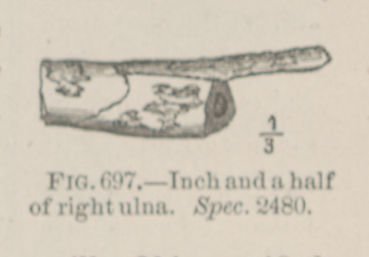Title: Painter, S.
Source text: The Medical and Surgical History of the War of the Rebellion. (1861-65.), Part 2, Volume 2 (Washington, DC: Government Printing Office, 1876), 955.
Civil War Washington ID: med.d2e30932
TEI/XML: med.d2e30932.xml
CASE 1912.—Private S. Painter, Co. K, 122d Ohio, aged 33 years, was wounded at Spottsylvania, May 12, 1864, and admitted to the field hospital of the 3d division, Sixth Corps, where Surgeon R. Barr, 67th Pennsylvania, recorded: "Gunshot wound of right forearm." On May 21st, the wounded man entered Finley Hospital, Washington. Surgeon G. L. Pancoast, U. S. V., reported: "Gunshot fracture of ulna, the ball entering the outer side of the forearm at the middle third. The missile was extracted by a surgeon on the field. On May 24th, an operation was performed, consisting of excision of the fractured ends by chain saw and the removal of the spiculæ. The wound healed by healthy granulations." The specimen, represented in the cut (FIG. 697), consists of the excised part of the ulna, amounting to one and a half inches. It was contributed by the operator. On February 4, 1865, the patient was discharged from service and pensioned. Examiner J. Nichols, of Washington, D. C., certified, February 11, 1865: "Removal of four inches of shaft. Pronation and supination lost. Loss of use of wrist joint by anchylosis. Loss of use of all the fingers by reason of injury to extensor tendons the fingers all remaining permanently extended. Limb quite useless and will never be restored." Examiner H. Culbertson, of Zanesville, Ohio, certified, January 13, 1870: " * * A portion of the flexor and extensor muscles, etc., on external aspect, are destroyed, producing contraction as well as partial atrophy. * * The elbow joint is normal. The motion of the wrist joint is unimpaired. The upper end of the lower fragment of the ulna is united to the radius by bony union. The function of rotation is obliterated," etc. Substantially the same was reported at an examination inSeptember, 1873. The pensioner was paid September 4, 1875.
